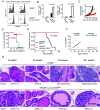Peripheral-derived regulatory T cells contribute to tumor-mediated immune suppression in a nonredundant manner
- PMID: 39207730
- PMCID: PMC11388331
- DOI: 10.1073/pnas.2404916121
Peripheral-derived regulatory T cells contribute to tumor-mediated immune suppression in a nonredundant manner
Abstract
Identifying tumor-mediated mechanisms that impair immunity is instrumental for the design of new cancer therapies. Regulatory T cells (Tregs) are a key component of cancer-derived immune suppression; however, these lymphocytes are necessary to prevent systemic autoimmunity in mice and humans, and thus, direct targeting of Tregs is not a clinical option for cancer patients. We have previously demonstrated that excising transcription factor Kruppel-like factor 2 (Klf2) within the T cell lineage blocks the generation of peripheral-derived Tregs (pTregs) without impairing production of thymic-derived Tregs. Using this mouse model, we have now demonstrated that eliminating pTregs is sufficient to delay/prevent tumor malignancy without causing autoimmunity. Cancer-bearing mice that expressed KLF2 converted tumor-specific CD4+ T cells into pTregs, which accumulated in secondary lymphoid organs and impaired further T cell effector activity. In contrast, pTreg-deficient mice retained cancer-specific immunity, including improved T cell infiltration into "cold" tumors, reduced T cell exhaustion in tumor beds, restricted generation of tumor-associated myeloid-derived suppressor cells, and the continued production of circulating effector T cells that arose in a cancer-dependent manner. Results indicate that tumor-specific pTregs are critical for early stages of cancer progression and blocking the generation of these inhibitory lymphocytes safely delays/prevents malignancy in preclinical models of melanoma and prostate cancer.
Keywords: KLF2; melanoma; pTregs; prostate cancer; regulatory T cells.
Conflict of interest statement
Competing interests statement:The authors declare no competing interest.
Figures




References
-
- Khattri R., Cox T., Yasayko S. A., Ramsdell F., An essential role for scurfin in Cd4+Cd25+ T regulatory cells. Nat. Immunol. 4, 337–342 (2003). - PubMed
-
- Fontenot J. D., Gavin M. A., Rudensky A. Y., Foxp3 programs the development and function of Cd4+Cd25+ regulatory T cells. Nat. Immunol. 4, 330–336 (2003). - PubMed
-
- Wildin R. S., et al. , X-Linked neonatal diabetes mellitus, enteropathy and endocrinopathy syndrome is the human equivalent of mouse scurfy. Nat. Genet. 27, 18–20 (2001). - PubMed
-
- Shimizu J., Yamazaki S., Sakaguchi S., Induction of tumor immunity by removing Cd25+Cd4+ T cells: A common basis between tumor immunity and autoimmunity. J. Immunol. 163, 5211–5218 (1999). - PubMed
MeSH terms
Substances
Grants and funding
LinkOut - more resources
Full Text Sources
Medical
Molecular Biology Databases
Research Materials

